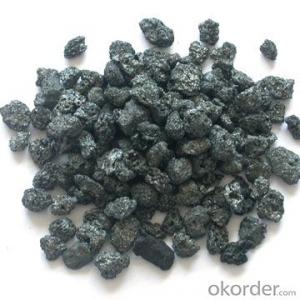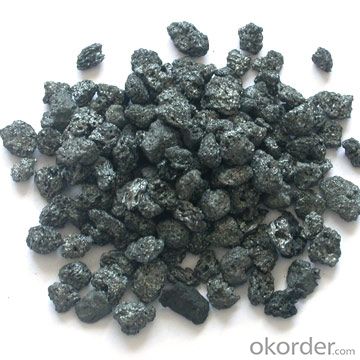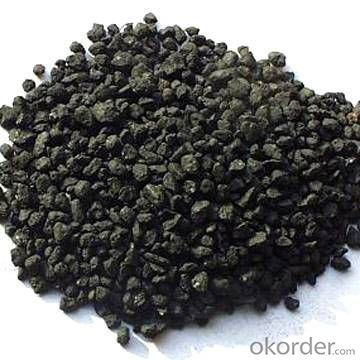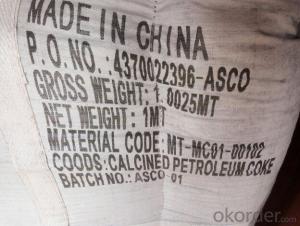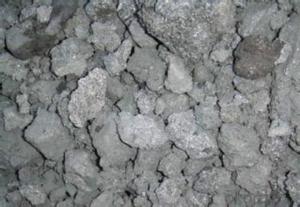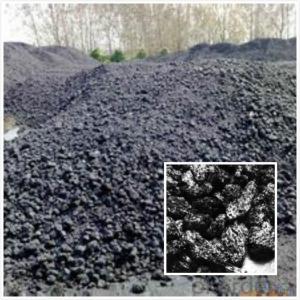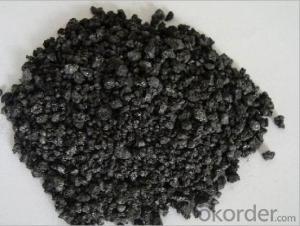Calcined Petroleum Coke with 98.5 Carbon
- Loading Port:
- Tianjin
- Payment Terms:
- TT OR LC
- Min Order Qty:
- 1 m.t.
- Supply Capability:
- 10000000 m.t./month
OKorder Service Pledge
OKorder Financial Service
You Might Also Like
1.Structure of Calcined Petroleum Coke Description
Calcined Petroleum Coke is made from raw petroleum coke,which is calcined in furnace at a high temperature(1200-1300℃).CPC/Calcined Petroleum Coke is widely used in steelmaking,castings manufacture and other metallurgical industry as a kind of recarburizer because of its high fixed carbon content,low sulfur content and high absorb rate.Besides,it is also a best kind of raw materials for producing artifical graphite(GPC/Graphitized Petroleum Coke) under the graphitizing temperature(2800℃).
2.Main Features of the Calcined Petroleum Coke
High-purity graphitized petroleum coke is made from high quality petroleum coke under a temperature of 2,500-3,500°C. As a high-purity carbon material, it has characteristics of high fixed carbon content, low sulfur, low ash, low porosity etc.It can be used as carbon raiser (Recarburizer) to produce high quality steel,cast iron and alloy.It can also be used in plastic and rubber as an additive.
3. Calcined Petroleum Coke Images
4. Calcined Petroleum Coke Specification
| Place of Origin: | China (Mainland) | Type: | Petroleum Coke | Sulphur Content (%): | 0.5 |
| Ash Content (%): | 1 | Fixed Carbon (%): | 98.5 | Moisture (%): | 1 |
| Volatile Matter (%): | 0.5 | Brand Name: | CNBM | Model Number: | 98.5 CPC |
| function: | steel-making and founding as a kind of car |
5.FAQ of Calcined Petroleum Coke
1). Q: Are you a factory or trading company?
A: We are a factory.
2). Q: Where is your factory located? How can I visit there?
A: Our factory is located in ShanXi, HeNan, China. You are warmly welcomed to visit us!
3). Q: How can I get some samples?
A: Please connect me for samples
4). Q: Can the price be cheaper?
A: Of course, you will be offered a good discount for big amount.
- Q: There is a graphite mine, looking for three experts engaged in mineral processing industry asked. They say earthy graphite, and the answer to the taste is quite different. Some say that the fixed carbon content of 15, and some say graphite grade 90%. The same sample. Some people say that very valuable, and some say that the grade is too low, worthless. I'm all confused. What do you mean by graphite grade and fixed carbon?
- The taste of graphite powder refers to its purity, that is, the amount of carbon; fixed carbon content refers to the removal of water, ash and volatile residues, it is an important indicator of the use of coal. The two are essentially different
- Q: How does carbon affect the formation of heatwaves?
- Carbon dioxide, a greenhouse gas, plays a significant role in the formation of heatwaves. When carbon dioxide is released into the atmosphere through human activities such as burning fossil fuels and deforestation, it acts as a blanket, trapping heat from the sun and preventing it from escaping back into space. This phenomenon is known as the greenhouse effect. As carbon dioxide levels continue to rise, the Earth's temperature also increases, leading to more frequent and intense heatwaves. The excess heat trapped in the atmosphere creates a feedback loop, further exacerbating the problem. Heatwaves occur when high-pressure systems stall over a region for an extended period, causing temperatures to soar well above average. Carbon not only influences the intensity of heatwaves but also their duration. The increased greenhouse effect prolongs the time during which heatwaves persist, making them more dangerous and damaging. This prolonged exposure to extreme heat can have severe consequences on human health, leading to heat-related illnesses, increased mortality rates, and reduced productivity. Furthermore, carbon emissions contribute to climate change, which alters weather patterns and leads to more extreme events like heatwaves. Climate models project that heatwaves will become more frequent, longer-lasting, and intense in the future if carbon emissions are not significantly reduced. Addressing the issue of carbon emissions is crucial in mitigating the impacts of heatwaves. Transitioning to cleaner and renewable energy sources, implementing energy efficiency measures, and promoting reforestation efforts are some of the steps that can be taken to reduce carbon dioxide levels. By doing so, we can mitigate the formation of heatwaves and protect both human health and the environment.
- Q: How does carbon impact the prevalence of earthquakes?
- The prevalence of earthquakes is not directly influenced by carbon. Instead, earthquakes are primarily caused by the movement of tectonic plates, which are massive sections of the Earth's crust that float on the semi-fluid layer beneath. When these plates collide, slide past each other, or separate, seismic waves are released, resulting in an earthquake. On the other hand, carbon is a chemical element that exists in various forms in the Earth's atmosphere, oceans, and living organisms. Human activities, such as emitting carbon dioxide (CO2), contribute to climate change and impact the Earth's ecosystems. However, there is no direct connection between carbon emissions and the prevalence of earthquakes. Nevertheless, it is important to note that some geologists and scientists suggest that human activities, such as extracting fossil fuels, may indirectly affect seismic activity. The extraction of large quantities of oil, gas, or water from the Earth's crust can potentially alter underground pressure and stress distribution, potentially triggering induced earthquakes. These induced earthquakes are usually of low magnitude and limited to the specific extraction area. Overall, while carbon emissions and human activities may have some localized impact on seismic activity, the global prevalence of earthquakes is mainly driven by tectonic plate movements and is not directly influenced by carbon.
- Q: What is carbon fiber reinforced plastic?
- Carbon fiber reinforced plastic (CFRP) is a composite material made up of carbon fibers embedded in a polymer matrix, typically epoxy resin. It combines the lightweight and high strength properties of carbon fibers with the versatility and durability of plastic. CFRP is widely used in various industries, including aerospace, automotive, and sports, due to its exceptional strength-to-weight ratio, resistance to corrosion, and excellent stiffness.
- Q: What are the carbon monoxide collection methods?
- Drainage methodExhaust air cannot be used because CO is poisonous
- Q: What are the alternatives to fossil fuels for energy production?
- Renewable energy sources such as solar, wind, hydroelectric, geothermal, and biomass are considered as alternatives to fossil fuels for energy production. These sources provide a sustainable and cleaner option, as they do not contribute to greenhouse gas emissions and are replenishable.
- Q: How does carbon affect the fertility of soil?
- Carbon is essential for maintaining and enhancing soil fertility. It provides a food source for soil microorganisms, promotes nutrient availability, and improves soil structure, water holding capacity, and overall soil health. Additionally, carbon helps increase the capacity of soil to retain and release nutrients, creating a favorable environment for plant growth and enhancing soil fertility.
- Q: What are the properties of carbon-based lubricants?
- Carbon-based lubricants have several important properties. Firstly, they have a low friction coefficient, which means they reduce friction between moving parts, thereby minimizing wear and tear. Additionally, carbon-based lubricants have excellent thermal stability, allowing them to perform effectively even at high temperatures. They also exhibit good chemical stability, resisting degradation and maintaining their lubricating properties over time. Furthermore, carbon-based lubricants are typically non-toxic and environmentally friendly, making them a preferred choice in many applications.
- Q: How is carbon formed in stars?
- Nuclear fusion is the process by which carbon is produced in stars. Hydrogen atoms in the star's core go through a series of fusion reactions, eventually combining to form helium. This fusion process emits a massive amount of energy and is responsible for the heat and light emitted by stars. As the star's core grows hotter and the pressure increases, helium atoms begin to fuse, creating heavier elements. At a certain point, three helium nuclei can come together to form a carbon nucleus. This process, called the triple alpha process, requires specific conditions, including high temperature and pressure, for it to occur. The triple alpha process relies on the fact that carbon-12 possesses a distinct energy level that allows three helium nuclei to unite and create a stable carbon nucleus. This is due to the perfect alignment of carbon-12's energy level with those of helium nuclei, enabling them to overcome electrostatic repulsion and fuse together. Once carbon is generated in the star's core, it can undergo further fusion reactions, resulting in the creation of even heavier elements like oxygen and nitrogen. These elements are vital building blocks for the formation of planets, including our own Earth, as they eventually get expelled into space during the later stages of a star's evolution.
- Q: other parameters are figured out, the difference is only in the carbon and carbon is not very clear, just know that they are winding mode is the opposite, there are two kinds of most printers can be used, what is the difference between the performance of them? Two can use the printer in the selection of the best carbon or carbon? Why? Please cite several models as an example.Please answer in your own words. Don't factor,
- In fact, to teach you a simple way to distinguish between internal and external carbon, carbon, label paper dip ribbon, with black on the outside of the outer side is carbon, carbon is in inside, no performance difference, now generally used is the most carbon, such as the machine is to use carbon is better, because the wound is not the same, sometimes loose.
Send your message to us
Calcined Petroleum Coke with 98.5 Carbon
- Loading Port:
- Tianjin
- Payment Terms:
- TT OR LC
- Min Order Qty:
- 1 m.t.
- Supply Capability:
- 10000000 m.t./month
OKorder Service Pledge
OKorder Financial Service
Similar products
Hot products
Hot Searches
Related keywords

